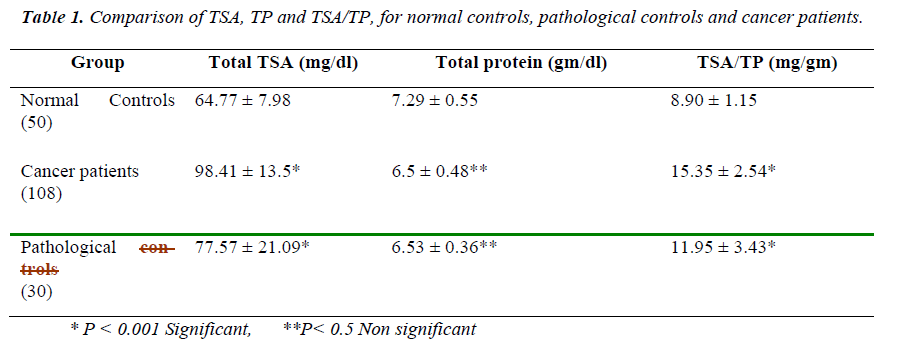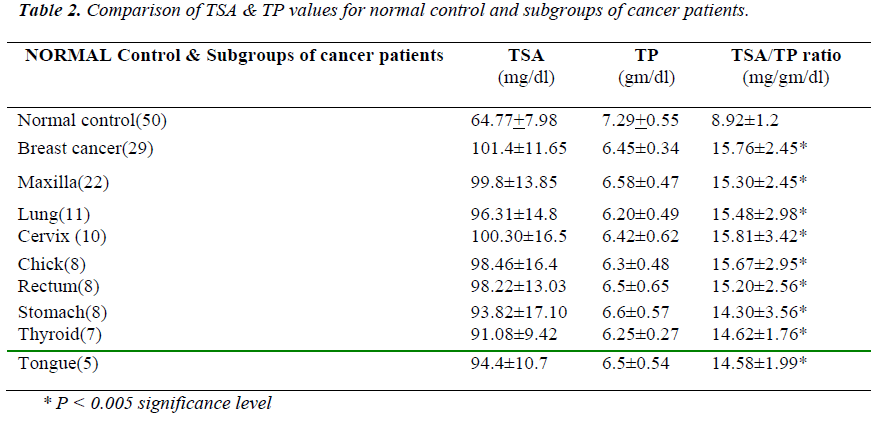- Biomedical Research (2011) Volume 22, Issue 4
Alterations in Total Sialic Acid (TSA), Total Proteins (TP) and TSA/TP ratio in cancer patients
Pushpa Durgawale1*, Ajit Sontakke1, P.S. Shukla2, Pratik Durgawale3, Pandurang Chougule41Department of Biochemistry, Krishna Institute of Medical Sciences, Karad
2Dept of Biochemistry, Manipal Institute Medical Sciences, Pokhara, Nepal
3Kolhapur Institute of Technology, Kolhapur
4Dept of Surgery, Krishna Institute of Medical Sciences
- Corresponding Author:
- Pushpa Durgawale
Department of Biochemistry
KIMS, Karad 415110
Maharashtra, India
Accepted Date: May 21 2011
Abstract
Total serum sialic acid (TSA), total proteins (TP) and TSA/TP ratio (as tumor markers) have been estimated in 108 cancer patients, 30 pathological controls and 50 normal healthy controls. Data analysis indicated a significant increase (p< 0.001) in the TSA and TSA/TP ratio in cancer patients (98.41 ± 13.5 mg/dl and 15.31 ± 2.57 mg/gm) as compared to patho-logical controls (77.57 ± 21.09 mg/dl and 11.94 ± 3.43 mg/gm) and normal control (64.77 ± 7.98 mg/dl and 8.9 ± 1.15mg/gm) respectively. A significant decrease (p<0.001) in serum lev-els of total proteins were found in all cases of cancer compared to the normal (6.46 ± 0.48 mg/dl and 7.29 ± 0.55 gm/dl) and pathological controls (6.53 ± 0.36 gm/dl).Further analysis of the data in patient subgroups of malignancy based on tissue involved indicated that the lack of specificity of the markers but the sensitivity of TSA and TSA/TP increased as the malignancy become more severe. The results show that TSA/TP was the most useful marker for detecting malignancies
Keywords
Sialic acid, Serum protein, Cancer.
Introduction
Tumor markers are the substances specific for certain tu-mor or cancer cells and thus could be of appreciable diag-nostic value in cancer patients [1]. The cell surface mem-brane is chiefly composed of glycoproteins and glycolip-ids. Any intracellular micro environmental change may lead to alteration in the surface membrane constituents, releasing certain molecules in the blood of such patients. Since a sialic acid is one of the major components of cell membranes, its expected alteration in sera of cancer pa-tient has been reported by a few workers [2,3]. The utility of lipid-associated sialic acid has been emphasized [4,5]. In a parallel study, changes in total serum proteins (TP), total serum sialic acid (TSA) and TSA/TP have been documented [6]. A comprehensive study to find out the best suitable marker is of immense value to the knowl-edge of oncology.
Present study was undertaken to evaluate the relative util-ity of serum levels of TSA, TP and TSA/TP for detecting and /or monitoring the progression of cancer in a variety of patients and their reliability as cancer markers.
Materials and Methods
Institutional ethical committee approval was taken. In the present study 108 cancer patients, 30 pathological con-trols and 50 normal healthy controls were included. Whole blood samples were collected from normal con-trols (donors at a hospital blood bank with no apparent disease), pathological controls (nonmalignant) and cancer patients (with different sites and degrees of biopsy-proved cancer). Blood samples were allowed to clot at room tem-perature and then centrifuged at 3000 rpm for 15 minutes and the resulting sera were placed into test tubes for analysis. . In this study the serum levels of TSA, TP and TSA/TP ratio were estimated. TSA was estimated by the method of Plucinsky et al [7]. TP was estimated by Biuret method [8].
Stastistical analysis
Statistical analysis was performed using SPSS-16.0 soft-ware. ANOVA test was used to determine if the mean values for TSA, TP and TSA/TP ratio were significantly different in the cancer, pathological control and control groups. P value < 0.01 was considered significant.
Results
Table I represents the comparisons of mean TSA, TP and TSA/TP ratio from the sera of cancer patients, pathologi-cal controls and normal controls. The TSA from the can-cer patients and pathological controls was significantly increased (P<0.001). When compared to normal controls. TP was significantly decreased (p<0.001) in the cancer patients and pathological controls compared to the normal controls. Total sialic acid values normalized to total pro-tein (TSA/TP) showed significant increase (p<0.001) for the cancer patients and the pathological controls when compared to normal controls. Also significant difference were noted when the TSA, TSA/TP values for the cancer patients were compared to those of the pathologic con-trols but alone TP values difference were no significant (P>0.5)
Table 2 represents comparisons of TSA, TP and TSA/TP values of the subgroups of cancer patients and normal controls. Compared to normal controls, a significant in-crease (p<0.001) in TSA was recorded in the cancer pa-tients subgroups. However, serum TP values were found to be significantly reduced (p < 0.001) for all cancer pa-tient subgroups when compared with the normal controls. Significant increases (p < 0.001) in TSA/TP values were also recorded in all cancer patient subgroups when com-pared to the normal controls.
Discussion
In the present investigation, levels of TSA, TP and TSA/TP ratio were determined and compared in patients with malignant or nonmalignant diseases. In malignant cells the membrane glycoproteins and glycolipids have altered carbohydrate metabolism which could be respon-sible for all the abnormal behavior i.e. abnormal cell rec-ognition, cell adherence, antigenicity and invasiveness [8]. The glycoproteins and glycolipids can be released into the blood through increased turnover, secretion and/or shedding. Several studies have shown a positive association of glycoproteins with malignancies [9]. Since sialic acid is one of the major components of the cell membranes, its expected alteration in sera of cancer pa-tients, has been reported [10].
Although several researchers [11,12] have studied TSA, TP and TSA/TP ratio levels for the purpose of diagnosis and management of cancer, but rarely analyzed all the three parameters simultaneously [13].
Our results showed a significant rise in TSA levels in all cancer patients, the rise being directly proportional to the degree of metastasis. Rise in TSA levels could be attrib-uted to malignant potential and changes in immunogenic-ity due to nonspecific changes. It has been suggested that sialic acid may be closely related to tumor associated an-tigen [14]. It may also reflect an increased amount of cel-lular destruction due to rapid tumor growth.
TSA, TP and TSA/TP ratio were determined in our pa-tients with malignant diseases, patients with non malig-nant diseases (pathologic controls), and normal controls to determine that which of these markers might be most useful for detecting and monitoring the progression of malignant disease. TSA and TSA/TP ratio were signifi-cantly increased and TP were significantly decreased in both the cancer patients and pathologic controls when compared to normal controls.
Results of this investigation indicate that TSA/TP ratio seems to be the best tested markers. Although this marker is quite sensitive, it however, lacks specificity of the markers may be due to very small subgroup sample size in cancer and pathological control. However, these results do indicate that there is a significant increase in TSA and TSA/TP as malignant diseases progress, suggesting that these markers may be useful in monitoring or therapeutic interventions and disease progression.
References
- Marth E, Flaschka G, Stiegler S, Mose J. Sialic acid as a marker for differentiation between benign and ma-lignant intracranial tumors. Clinica Chimica Acta. 1988; 176: 251-258.
- Macbeth RAI, Bekei. JG. Plasma glycoprotein in vari-ous disease states including carcinoma. Cancer Re-search. 1962; 23: 1170.
- Winnzler R.J. Methods of biochemical analysis II. In-terscience Publisher, New York. P. 279, 1958.
- Erbil K, Jones J, Klee G. Use and limitations of serum total and lipid bound sialic acid concentrations as markers for colorectal cancer. Cancer.1985; 55: 404-409.
- Katopodis N, Hirshaut Y, Geller N, Stock C. Lipid associated sialic acid test for the detection of human cancer. Cancer Research.1982; 42: 5270-5275.
- Plucinsky M, Riley W, Michael, PJ, Alhadeff J. Total and lipid associated serum sialic acid levels in cancer patients with different primary sites and differing de-grees of metastatic involvement, Cancer.1986; 58: 2680-2685.
- Mark C, Plucinsky W, Michael RJP, Jack A. Total and lipid-Associated serum sialic acid levels in cancer pa-tients with different primary sites and differing degrees of metastatic involvement. Cancer. 1986. 12: 2680-2685.
- Varley H: Practical clinical Biochemistry IV Edition; Arnold Heinemann Pub. India. P. 172, 1975.
- Hakomori S. Tumor associated carbohydrate antigens. Ann Rev Immunol. 1984; 2:103-126.
- Arivazhagan S, Kavitha K, Nagini S. Glycocojugate profile in plasma and erythrocytes of gastric cancer pa-tients. Ind J Physiol Pharmacol. 1998; 42: 123-126.
- Tewarson S, Mittal V, Singh M, Gupta G. Serum sialic acid - an important cancer marker. Ind J Cancer. 1993; 30: 125-131.
- Silver H, Rengel D, Morto I. Serum sialic acid eleva-tions in malignant melanoma patients. Cancer 1978; 41:1497-1499.
- Singh R, Sur B, Agarwal S, Ramaraju B. Serum sialic acid in malignancy. Ind J Med Res.1967; 55: 3: 270-273.
- Raval G, Parekh L, Ptel D, Jha F, Sainge R, Patel P. Clinical usefulness of alterations in sialic acid, Sialy-transferase and sialoproteins in breast cancer. Ind J Clin Bio 2004; 19: 60-72.

